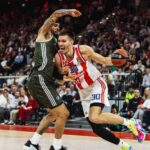
Gallo of the good old days?
We all know the NBA needs specialists, and that this is a request asked particularly of non-American players who haven’t the status in the ‘States to claim balls and minutes while they’re newly arrived from Europe. Then, by fighting for minutes against and using smarts beyond the US players, young European players soon present more balanced games week to week to increase their stay on floor, even if sometimes months are needed before someone notices.
Now that European basketball has grown up, these rules are no longer necessarily valid, because the gap between a Dirk Nowitzki and a Kevin Garnett – technically – isn’t as wide as 10-15 years ago. It’s easy to see a European star going to the NBA and playing the same basketball played before, with nearly the same minutes and responsibilities: This was the case with Pau Gasol, Hedo Turkoglu, Jose Calderon, Andrea Bargnani, and Luis Scola.
In contrast is Danilo Gallinari. As the no. 6 overall pick of the 2008 NBA Draft, Gallinari came to New York as probably the best 20-year-old swingman of his class, with a Euroleague 2008 Rising Star Trophy on his résumé. A mixture of height, sweet hands, quick feet and impudence, we used to say the former Milano forward was ready to follow in the footsteps of Turkoglu, the player he most closely resembled in skill. After a bad season characterized by his own back problems and the Knicks’ continuing struggles, Gallinari is today a new man.
He’s a starter – in place of Al Harrington, who went for 20.7 and 6.3 rebounds per game last year –averaging 13.1 points. No matter: New York would be losing anyway, and coach Mike D’Antoni emphasizes Gallinari’s development instead. You’re free to think that this is merely another way to keep attention to his disastrous team far from the Garden, or maybe it’s a tactic suggesting to Lebron James and other 2010 free agents, “Hey, come to the Big Apple, we’ve a star-in-waiting!”
OK, Gallinari’s improved a lot, but it’s his type of play that doesn’t convince at all. What has remained from that wonderful boy able to play the inside-out game, run the floor, and score from either from the low- or the high-post? “Gallinari is the best shooter in the League, the most polished I’ve ever coached” goes D’Antoni’s thought often-expressed to his player and to the media. Simple. Now, who takes advantage of a similar situation? Does Gallinari really step up as NBA player by taking 65% of his field goals (110 of 179 made) from beyond the arc? Is New York getting themost out of the Italian this way?
In part, the answer can be seen in the terrible 3-14 record with which the Knicks have begun their season, or if you like in the inability (maybe better to say “insecurity”) which with Gallinari is putting the ball on the floor, no longer accustomed as he is to doing such; Gallinari’s offensive efficiency is due to three-pointers and tap-ins, second-chance points he scores near the basket thanks to his 208-cm height.
The point is that Gallinari has become a very dangerous (or “natural” in D’Antoni’s words) shooter from distance, going 43.6% from beyond the arc after 17 games, so he feels no need to penetrate the middle and do all the other tasks a pure small forward is supposed to do. When Hedo Turkoglu landed in the US, he was a point forward without long-distance range; during his ten NBA years he has been working on that lack (culminating in a 41.3% success rate last year with Orlando), but Turkoglu’s trademarks and style of play have never changed. Gallinari’s not following Turkoglu’s path, and now he’s closer to a Juan Carlos Navarro, another scorer who returned to Europe when he understood he could score in double figures just by shooting from outside: Twelve months after his arrival to the Memphis Grizzlies, Navarro preferred a starring role in Barcelona to a specialist’s in Tennessee.
Summer 2010 is the key for “Gallo.” If Lebron James – or Chris Bosh, Dwyane Wade, Joe Johnson, etc. – won’t come to New York, the Knicks would confirm themselves as one of the losing teams in the league (because their sure 2010 lottery pick in the draft goes to the Utah Jazz) and Gallinari could feel as though he’s wasted two years for nothing. Consider Navarro’s example: Specializing for a contender is not the same as playing the specialist on a 20-win-a-year club. Rudy Fernandez, whose potential isn’t smaller than Gallinari’s, has comprehended that, and his 79 shots from the distance on 127 field goals made (a 62% rate) are radically different from those made by the Italian: Fernandez is now the sixth man on a winning team, often plays when it counts, and will be co-star on a Western Conference contender.
Again, at the moment, what is Danilo Gallinari?
–written by Francesco Cappelletti




